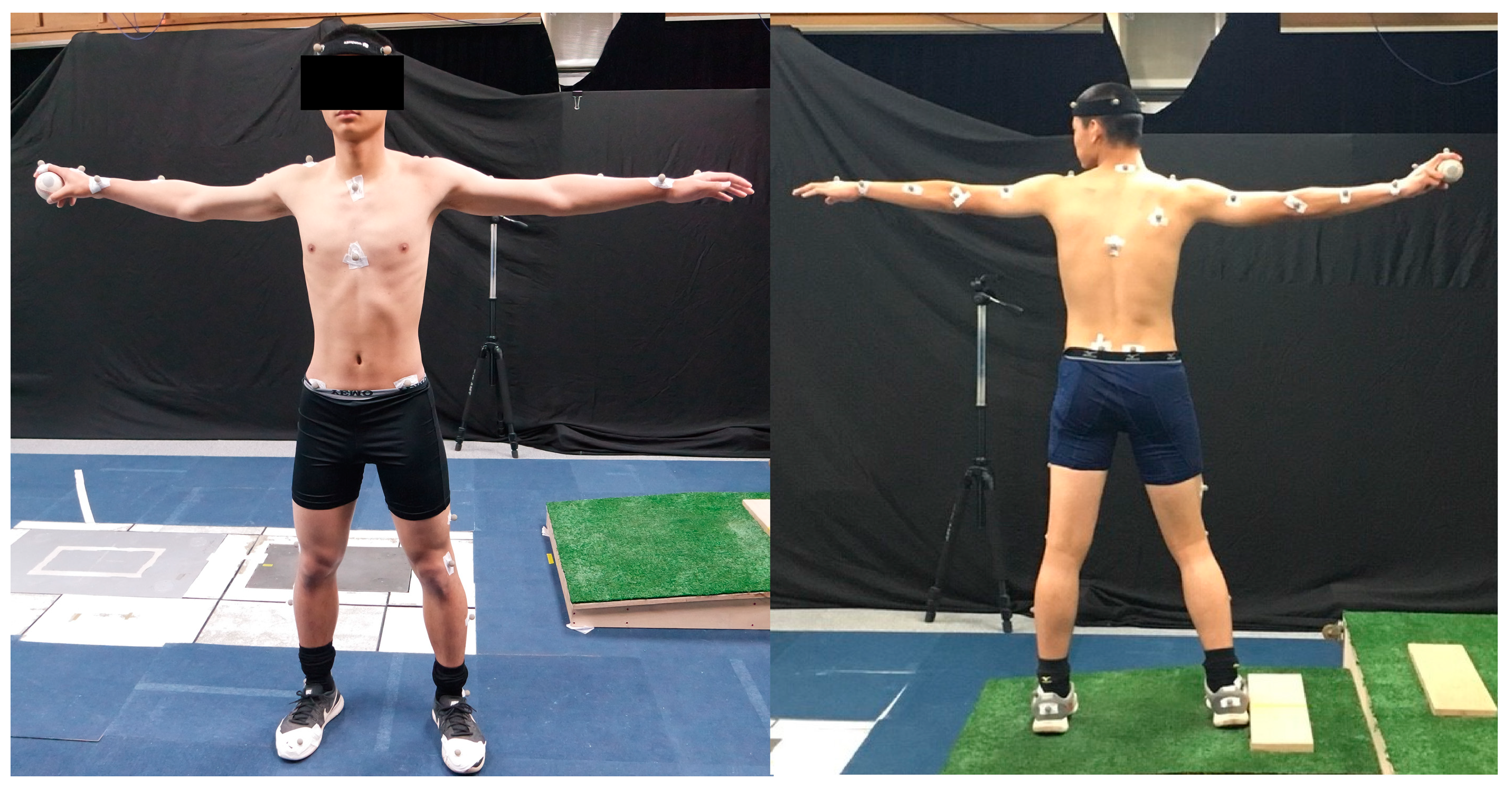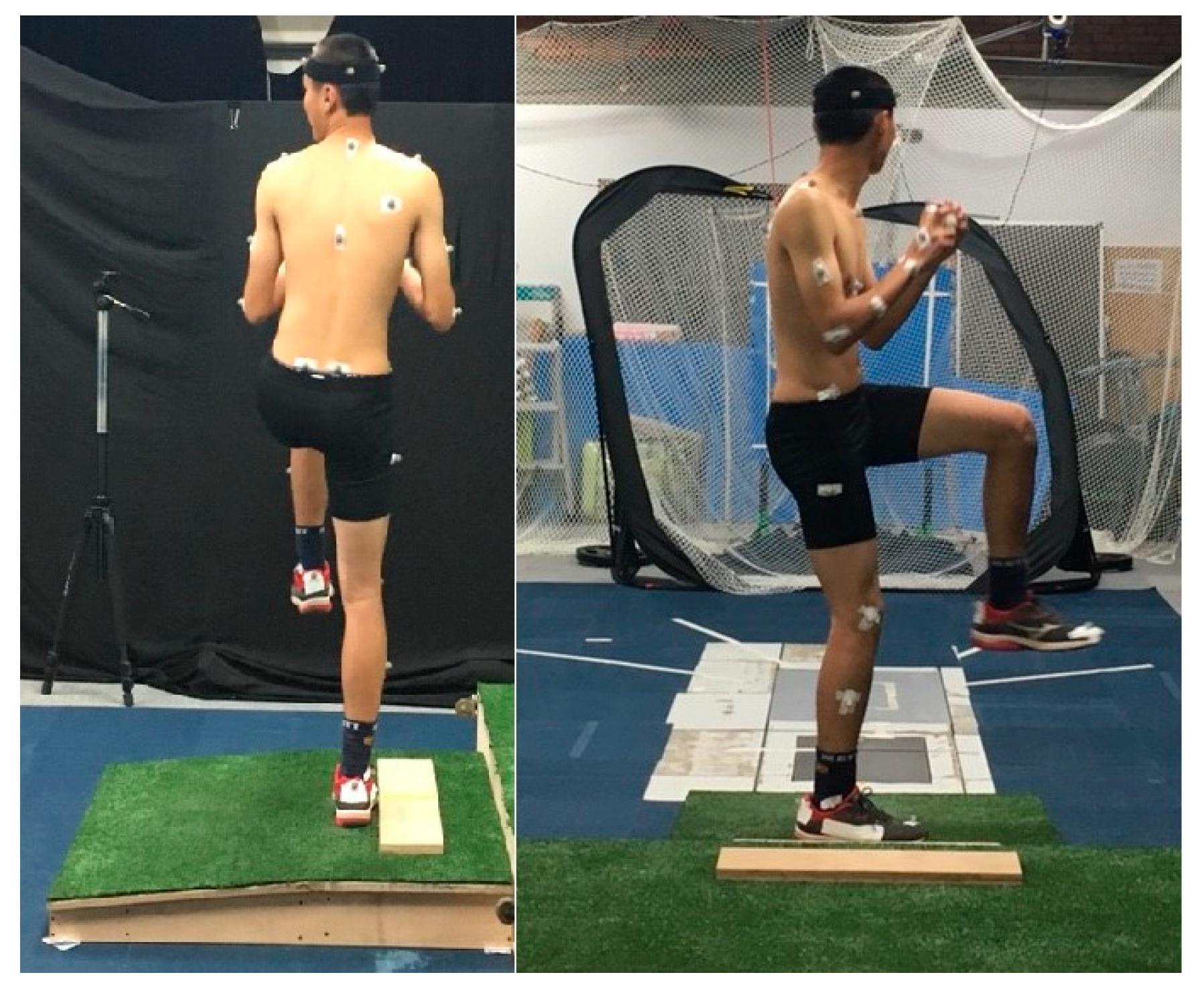The Relationship between the Glenohumeral Joint Internal Rotation Deficit and the Trunk Compensation Movement in Baseball Pitchers
Abstract
1. Introduction
2. Materials and Methods
2.1. Subjects
2.2. Procedures and Instrumentation
2.3. Statistical Analysis
3. Results
4. Discussion
5. Conclusions
Author Contributions
Funding
Institutional Review Board Statement
Informed Consent Statement
Data Availability Statement
Conflicts of Interest
References
- Fleisig, G.S.; Andrews, J.R.; Dillman, C.J.; Escamilla, R.F. Kinetics of baseball pitching with implications about injury mechanisms. Am. J. Sports Med. 1995, 23, 233–239. [Google Scholar] [CrossRef]
- Putnam, C.A. Sequential motions of body segments in striking and throwing skills: Descriptions and explanations. J. Biomech. 1993, 26, 125–135. [Google Scholar] [CrossRef]
- Matsuo, T.; Escamilla, R.F.; Fleisig, G.S.; Barrentine, S.W.; Andrews, J.R. Comparison of Kinematic and Temporal Parameters between Different Pitch Velocity Groups. J. Appl. Biomech. 2001, 17, 1–13. [Google Scholar] [CrossRef]
- Werner, S.L.; Suri, M.; Guido, J.A., Jr.; Meister, K.; Jones, D.G. Relationships between ball velocity and throwing mechanics in collegiate baseball pitchers. J. Shoulder Elb. Surg. 2008, 17, 905–908. [Google Scholar] [CrossRef] [PubMed]
- Laudner, K.G.; Stanek, J.M.; Meister, K. Assessing posterior shoulder contracture: The reliability and validity of measuring glenohumeral joint horizontal adduction. J. Athl. Train. 2006, 41, 375–380. [Google Scholar] [PubMed]
- Tyler, T.F.; Nicholas, S.J.; Roy, T.; Gleim, G.W. Quantification of posterior capsule tightness and motion loss in patients with shoulder impingement. Am. J. Sports Med. 2000, 28, 668–673. [Google Scholar] [CrossRef] [PubMed]
- Burkhart, S.S.; Morgan, C.D.; Kibler, W.B. The disabled throwing shoulder: Spectrum of pathology Part III: The SICK scapula, scapular dyskinesis, the kinetic chain, and rehabilitation. Arthrosc. J. Arthrosc. Relat. Surg. 2003, 19, 641–661. [Google Scholar] [CrossRef]
- Guney, H.; Harput, G.; Colakoglu, F.; Baltaci, G. The Effect of Glenohumeral Internal-Rotation Deficit on Functional Rotator-Strength Ratio in Adolescent Overhead Athletes. J. Sport Rehabil. 2016, 25, 52–57. [Google Scholar] [CrossRef] [PubMed]
- Myers, J.B.; Laudner, K.G.; Pasquale, M.R.; Bradley, J.P.; Lephart, S.M. Glenohumeral range of motion deficits and posterior shoulder tightness in throwers with pathologic internal impingement. Am. J. Sports Med. 2006, 34, 385–391. [Google Scholar] [CrossRef] [PubMed]
- Dines, J.S.; Frank, J.B.; Akerman, M.; Yocum, L.A. Glenohumeral internal rotation deficits in baseball players with ulnar collateral ligament insufficiency. Am. J. Sports Med. 2009, 37, 566–570. [Google Scholar] [CrossRef]
- Chen, Y.C. The Development of Glenohumeral Internal Rotation Deficit and the Impact to Throwing Technique in Student Baseball Pitchers in Taiwan; Graduate Institute of Athletics and Coaching Science, National Taiwan Sport University: Taoyuan, Taiwan, 2012. [Google Scholar]
- Cheng, S.C.; Lin, S.M.; Lin, W.J. The potential impact from glenohumeral internal rotation deficit to the knee kinematics in baseball pitchers: A case-control study. Medicine 2021, 100, e24066. [Google Scholar] [CrossRef] [PubMed]
- Norkin, C.C.; White, D.J. Measurement of Joint Motion: A Guide to Goniometry; F.A. Davis: Philadelphia, PA, USA, 2009. [Google Scholar]
- Cheng, S.C.; Chang, H.Y.; Chen, Y.Z.; Chang, Y.P. The development of glenohumeral internal rotation deficit and the impact to throwing technique in student baseball pitchers in Taiwan. In Proceedings of the Taiwan Society of Biomechanics in Sports Annual Conference 2011, Taoyuan, Taiwan, 7–11 July 2011. [Google Scholar]
- Chou, P.P.; Chou, Y.L.; Wang, Y.S.; Wang, R.T.; Lin, H.T. Effects of glenohumeral internal rotation deficit on baseball pitching among pitchers of different ages. J. Shoulder Elbow Surg. 2018, 27, 599–605. [Google Scholar] [CrossRef]
- Fleisig, G.; Chu, Y.; Weber, A.; Andrews, J. Variability in baseball pitching biomechanics among various levels of competition. Sports Biomech. 2009, 8, 10–21. [Google Scholar] [CrossRef]
- Whiteside, D.; Martini, D.N.; Zernicke, R.F.; Goulet, G.C. Ball speed and release consistency predict pitching success in Major League Baseball. J. Strength Cond. Res. 2016, 30, 1787–1795. [Google Scholar] [CrossRef]
- Hurd, W.J.; Kaplan, K.M.; ElAttrache, N.S.; Jobe, F.W.; Morrey, B.F.; Kaufman, K.R. A profile of glenohumeral internal and external rotation motion in the uninjured high school baseball pitcher, part II: Strength. J. Athl. Train. 2011, 46, 289–295. [Google Scholar] [CrossRef] [PubMed]
- Oyama, S.; Hibberd, E.E.; Myers, J.B. Preseason screening of shoulder range of motion and humeral retrotorsion does not predict injury in high school baseball players. J. Shoulder Elbow Surg. 2017, 26, 1182–1189. [Google Scholar] [CrossRef]
- Wilk, K.E.; Macrina, L.C.; Arrigo, C. Passive range of motion characteristics in the overhead baseball pitcher and their implications for rehabilitation. Clin. Orthop. Relat. Res. 2012, 470, 1586–1594. [Google Scholar] [CrossRef] [PubMed]
- Shanley, E.; Rauh, M.J.; Michener, L.A.; Ellenbecker, T.S.; Garrison, J.C.; Thigpen, C.A. Shoulder range of motion measures as risk factors for shoulder and elbow injuries in high school softball and baseball players. Am. J. Sports Med. 2011, 39, 1997–2006. [Google Scholar] [CrossRef]
- Wilk, K.E.; Macrina, L.C.; Fleisig, G.S.; Porterfield, R.; Simpson, C.D.; Harker, P.; Paparesta, N.; Andrews, J.R. Correlation of glenohumeral internal rotation deficit and total rotational motion to shoulder injuries in professional baseball pitchers. Am. J. Sports Med. 2011, 39, 329–335. [Google Scholar] [CrossRef] [PubMed]
- Nakamizo, H.; Nakamura, Y.; Nobuhara, K.; Yamamoto, T. Loss of glenohumeral internal rotation in little league pitchers: A biomechanical study. J. Shoulder Elbow Surg. 2008, 17, 795–801. [Google Scholar] [CrossRef] [PubMed]
- Noonan, T.J.; Shanley, E.; Bailey, L.B.; Wyland, D.J.; Kissenberth, M.J.; Hawkins, R.J.; Thigpen, C.A. Professional Pitchers With Glenohumeral Internal Rotation Deficit (GIRD) Display Greater Humeral Retrotorsion Than Pitchers Without GIRD. Am. J. Sports Med. 2015, 43, 1448–1454. [Google Scholar] [CrossRef] [PubMed]
- Meyer, C.J.; Garrison, J.C.; Conway, J.E. Baseball Players With an Ulnar Collateral Ligament Tear Display Increased Nondominant Arm Humeral Torsion Compared With Healthy Baseball Players. Am. J. Sports Med. 2017, 45, 144–149. [Google Scholar] [CrossRef] [PubMed]
- Whiteley, R.J.; Adams, R.D.; Nicholson, L.L.; Ginn, K.A. Reduced humeral torsion predicts throwing-related injury in adolescent baseballers. J. Sci. Med. Sport 2010, 13, 392–396. [Google Scholar] [CrossRef] [PubMed]


| GIRD Group | Non-GIRD Group | p Value | |
|---|---|---|---|
| Age (years) | 16.64 ± 0.95 | 17.08 ± 1.23 | 0.339 |
| Height (cm) | 178.92 ± 3.82 | 179.15 ± 5.68 | 0.904 |
| Weight (kg) | 76.92 ± 6.6 | 76.59 ± 11.1 | 0.931 |
| Weekly baseball practice time (hours) | 21.08 ± 2.02 | 22.31 ± 1.7 | 0.114 |
| Pitching experience (years) | 5.08 ± 1.98 | 5.15 ± 2.18 | 0.933 |
| Total baseball experience (years) | 6.67 ± 1.67 | 7.04 ± 1.42 | 0.554 |
| Number of participants | 12 | 13 |
| GIRD Group | Non-GIRD Group | p | |
|---|---|---|---|
| Right external rotation (degree) | 96.42 ± 8.42 | 97.42 ± 6.6 | 0.741 |
| Right internal rotation | 40.71 ± 3.50 | 48.65 ± 9.01 | 0.009 * |
| Right horizontal adduction | 14.13 ± 2.86 | 15.42 ± 3.05 | 0.285 |
| Right total rotation | 137.13 ± 7.16 | 146.08 ± 10.96 | 0.025 * |
| Left external rotation | 85.67 ± 6.71 | 90.88 ± 7.11 | 0.072 |
| Left internal rotation | 65.75 ± 5.19 | 59.62 ± 8.52 | 0.042 * |
| Left horizontal adduction | 18.38 ± 4.28 | 18.81 ± 2.95 | 0.770 |
| Left total rotation | 151.42 ± 8.52 | 150.5 ± 9.52 | 0.803 |
| Upper Trunk Motion (Degree) | GIRD Group | Non-GIRD Group | p Value | Cohen’s d |
|---|---|---|---|---|
| Upper trunk rotation (SFC **) | −90.06 ± 9.64 | −88.32 ± 11.84 | 0.692 | 0.1605 |
| Upper trunk rotation (REL ***) | 27.39 ± 6.62 | 20.42 ± 5.97 | 0.011 * | 1.1082 |
| Upper trunk total rotation | 117.45 ± 11.55 | 109.12 ± 11.26 | 0.079 | 0.7307 |
| Upper trunk roll (SFC) | −4.50 ± 8.01 | −4.33 ± 5.13 | 0.950 | 0.0255 |
| Upper trunk roll (REL) | 24.70 ± 6.52 | 23.74 ± 6.21 | 0.710 | 0.1509 |
| Upper trunk flexion (SFC) | −1.94 ± 10.06 | 2.99 ± 7.45 | 0.175 | 0.5605 |
| Upper trunk flexion (REL) | 29.44 ± 4.87 | 33.47 ± 6.96 | 0.109 | 0.666 |
| Pelvic Rotation (Degree) | GIRD Group | Non-GIRD Group | p Value | Cohen’s d |
|---|---|---|---|---|
| Pelvic rotation (SFC **) | −63.63 ± 10.85 | −60.03 ± 11.35 | 0.427 | 0.3239 |
| Pelvic rotation (REL ***) | 17.25 ± 6.15 | 13.31 ± 10.91 | 0.283 | 0.44 |
| Total pelvic rotation | 80.88 ± 11.34 | 73.91 ± 11.88 | 0.148 | 0.5239 |
| Ball velocity (km/hr) | 113.21 ± 9.52 | 119.79 ± 7.52 | 0.067 | 0.7709 |
| overall pitching time(s) | 0.195 ± 0.024 | 0.174 ± 0.018 | 0.024 * | 0.996 |
| Rotation Direction (Degree) | GIRD Group | Non-GIRD Group | p Value |
|---|---|---|---|
| Pivot leg external rotation | 37.75 ± 7.97 | 38.38 ± 4.90 | 0.811 |
| Pivot leg internal rotation | 29.79 ± 6.77 | 35.62 ± 7.86 | 0.06 |
| Pivot leg total rotation | 67.54 ± 7.84 | 74.00 ± 7.07 | 0.041 * |
| Leading leg external rotation | 36.21 ± 7.45 | 38.42 ± 5.57 | 0.406 |
| Leading leg internal rotation | 29.75 ± 7.28 | 32.31 ± 7.20 | 0.387 |
| Leading leg total rotation | 65.96 ± 6.53 | 70.73 ± 7.65 | 0.109 |
Publisher’s Note: MDPI stays neutral with regard to jurisdictional claims in published maps and institutional affiliations. |
© 2021 by the authors. Licensee MDPI, Basel, Switzerland. This article is an open access article distributed under the terms and conditions of the Creative Commons Attribution (CC BY) license (http://creativecommons.org/licenses/by/4.0/).
Share and Cite
Cheng, S.-C.; Wan, T.-Y.; Chang, C.-H. The Relationship between the Glenohumeral Joint Internal Rotation Deficit and the Trunk Compensation Movement in Baseball Pitchers. Medicina 2021, 57, 243. https://doi.org/10.3390/medicina57030243
Cheng S-C, Wan T-Y, Chang C-H. The Relationship between the Glenohumeral Joint Internal Rotation Deficit and the Trunk Compensation Movement in Baseball Pitchers. Medicina. 2021; 57(3):243. https://doi.org/10.3390/medicina57030243
Chicago/Turabian StyleCheng, Shih-Chung, Ting-Yu Wan, and Chun-Hao Chang. 2021. "The Relationship between the Glenohumeral Joint Internal Rotation Deficit and the Trunk Compensation Movement in Baseball Pitchers" Medicina 57, no. 3: 243. https://doi.org/10.3390/medicina57030243
APA StyleCheng, S.-C., Wan, T.-Y., & Chang, C.-H. (2021). The Relationship between the Glenohumeral Joint Internal Rotation Deficit and the Trunk Compensation Movement in Baseball Pitchers. Medicina, 57(3), 243. https://doi.org/10.3390/medicina57030243






